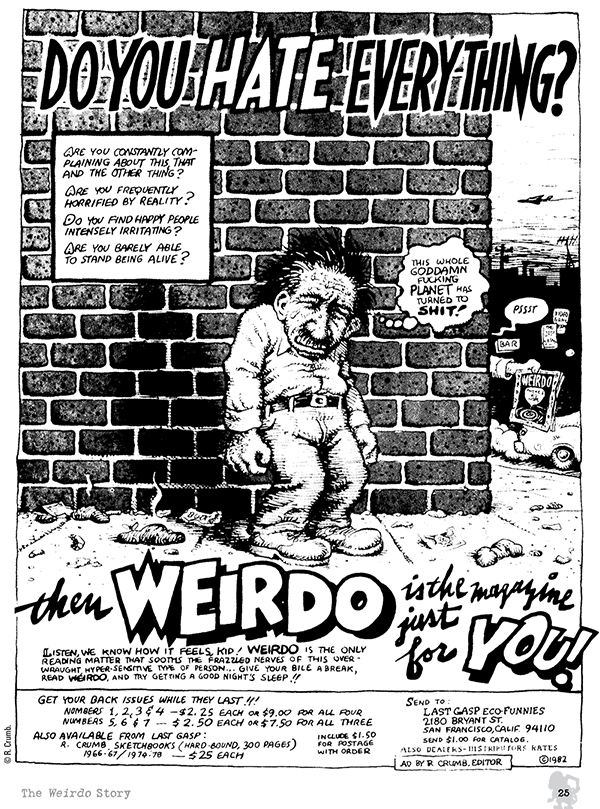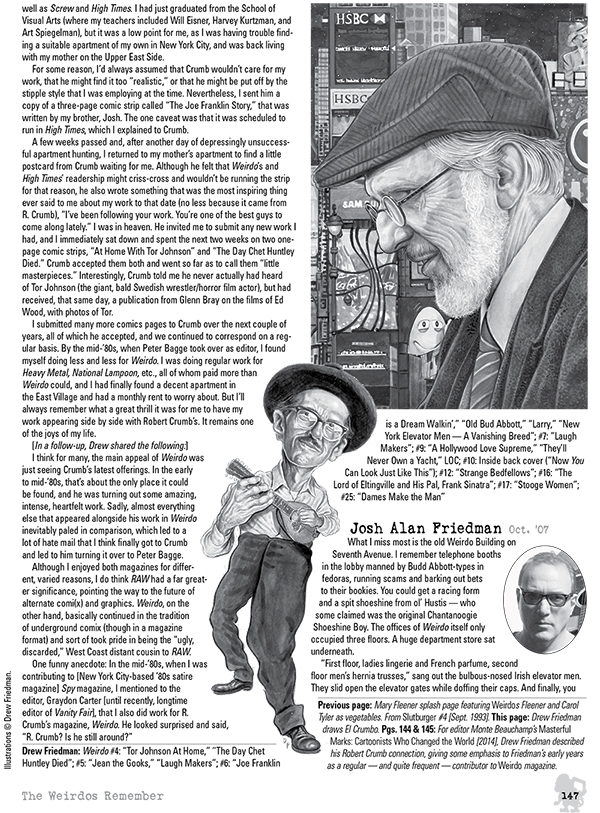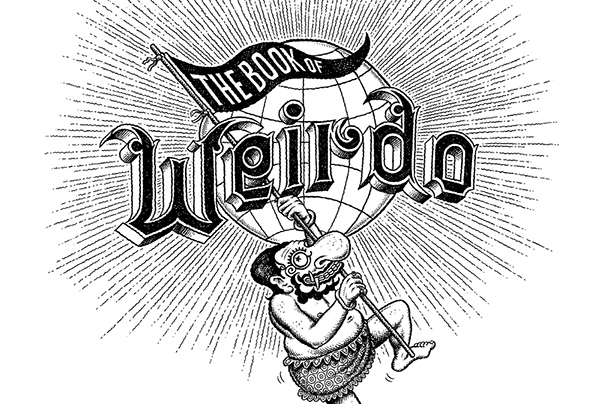If you’ve been following my recent columns here, you’ll know I’ve been on a bit of an ’80s counter-nostalgia binge, looking at an alternate history to the period, conjured from the last dregs of genuine counterculture before techno, grunge and the internet came to make us all as one. Well, ’80s reexamination seems to be a thing, as I keep coming across more new publications excavating that strange era. One of the main shout-outs I gave previously was to Weirdo, the underground comix anthology spearheaded by Robert Crumb, which carried the torch for idiosyncratic DIY self-expression through some of its darkest years. Lo and behold, Last Gasp has published Jon B. Cooke’s absurdly exhaustive Book of Weirdo, a 288-page hardcover history of the magazine and its significance, told in a mosaic of interviews, reminiscences and archival ephemera.

Reprinted from “The Book of Weirdo” by Jon B. Cooke. All rights reserved. Art (c) Robert Crumb.
Weirdo was started by Crumb in 1981—a point when the once lucrative and globally distributed underground comix scene was almost extinct. A deliberate throwback to the post-MAD aesthetics of Harvey Kurtzman’s Humbug, its early issues included a wide range of truly peculiar material—the ‘patacritical rants of Francis E. Dec, Esq.; the art and theoretical speculations of Stanislav Szukalski (see last ish); reports from The Church of the Subgenius; quirky vintage advertising art; genuine Outsider graphic narratives from B.N. Duncan, Norman F. Pettingill and Elinore Norflus, as well as the always odd staged photo-comic stories usually starring Crumb and a bevy of amazons. This heady mixture lasted for the nine issues edited by Crumb, after which punk-generation cutup Peter Bagge took the reins, followed by Crumb’s partner Aline Kominsky-Crumb—both of whom focused more exclusively on actual (and generally remarkable) comics.
The BoW functions as a how-to manual for historically significant DIY publishing but also as a subtle account of the shift in the nature of mediated human consciousness from the ’70s to the ’90s—a period that contained all such insurgent creative activities safely inside quotation marks. And while the Bagge/Kominsky era collected some of the most compelling comic work being done at the time, it also reflected a wider cultural imperative towards specialization and niche marketing. Those early Crumb issues hinted at something less containable and more polymorphous in its perversity, and there is a vein of puzzled wistfulness running through even the most matter-of-fact recollections.
Another example of ’80s publishing might-have-been has just emerged from Bay Area publisher Vale’s recent housecleaning efforts (see last ish). Robert Anton Wilson: Beyond Conspiracy Theory collects the remnants of what was meant to be a monographic introduction to a single fringe literary figure—a strategy that Vale’s RE/Search imprint had successfully deployed with avant-garde SF writer J.G. Ballard and Beat futurist William S. Burroughs.

Reprinted from “The Book of Weirdo” by Jon B. Cooke. All rights reserved. Art (c) Christoph Mueller.
Wilson—a peculiar blend of psychedelic occultist, libertarian skeptic and deconstructionist literary troublemaker—was largely responsible (with sometime collaborator Bob Shea) for unleashing the conspiracy-theory juggernaut of The Illuminati on an unsuspecting world, with the 1975 publication of their postmodern novels The Illuminatus! Trilogy, which described a secret war between the control-freak Illuminati and the anarchistic Discordians dating back to the beginnings of human history. The novels were an underground sensation, and were turned into a 12-hour experimental theater piece in Liverpool (which in turn inspired the formation of the KLF, but that’s another story).

Reprinted from “The Book of Weirdo” by Jon B. Cooke. All rights reserved. Art (c) Drew Friedman.
Wilson spent the rest of his career alternating between experimental fiction and unclassifiable journalism. He never achieved the same level of exposure that Illuminatus! afforded him (though his obsession with the Holy Blood Holy Grail/Priory of Sion kerfuffle undoubtedly contributed to the manifestation of The DaVinci Code—which may be what finally killed him off), and he developed into a quintessential cult author. A legendary raconteur, it’s fitting that the cornerstone of the new RE/Search volume is a typically free-associative interview. The other major section contains Wilson’s International Conspiracy Trivia Quiz, which will be the final exam next time I teach my Outsider Theory class. While a welcome addition to the RAW bibliography, its hard not to imagine what impact it might have made in its intended form—Vale outlines the original expanded contents, which would have been presented in the large-format and classic-industrial design of the Ballard and Burroughs volumes. Who knows—it could’ve finally immanentized the eschaton (see last ish)—or at least made the ’80s not suck quite so bad!



















0 Comments